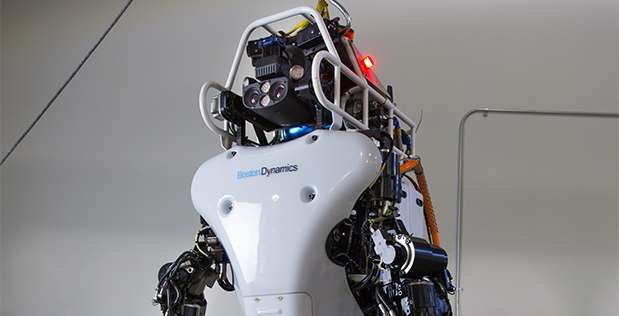February 26, 2016 weblog
Next-gen Atlas moves out the door and into the woods

Welcome to the new-generation Atlas, which is shaking up a lot of people's perceptions of robots. In the past, we have had no problem recognizing robots as cleverly engineered machines, never to be confused with humans.
Boston Dynamics is showing us a video now on a newcomer to its robot collection. Its new robot is more like us. In a video the new robot steps forth from his robot family, walks forward and pushes a heavy glass door to go outside. In the snowy wooded outdoors it walks, sometimes unsteadily, over the mounds of snow.
Back indoors, it lifts ten pound boxes from the ground and places them successfully on the shelves, at one go. His human torturer knocks the box out if its hands; in another thwart attempt he keeps pushing the box away with his stick as the robot steps closer and closer trying to recover it.
This version of Atlas is about 5' 9" tall (about a head shorter than the DRC Atlas) and weighs 180 pounds.
Make no mistake, we're looking at "a huge technological leap forward compared to its predecessor," stated Erico Guizzo and Evan Ackerman in IEEE Spectrum. The robot is electrically powered and hydraulically actuated.
Tim Biggs, technology reporter, The Sydney Morning Herald, finds no argument that the new robot marks more than just finger-pointing amusement.
"Boston Dynamics is renowned online for its quirky videos of new robots that don't seem quite ready to handle the tasks they're attempting—stumbling like babies over rough terrain or being shoved and kicked by researchers until they fall flat on their metal face," he wrote. Nonetheless, that same uneven nature is also the team's most impressive aspect in the design and testing of robots.
"Staying upright while navigating uneven terrain and adjusting for unexpected complications is an extraordinarily involved process, requiring constant adjustment that's difficult to come by without a brain and central nervous system."
The next-gen ATLAS, after all, does not only slip and stumble on snow but it rapidly recovers its balance time after time and it continues on foot.
Marc Raibert, founder and president of Boston Dynamics, said in IEEE Spectrum that making the robot lighter and more compact took a huge amount of work.
Raibert said his controls team has been developing new algorithms and refining the old ones, "taking advantage of the improved strength-to-weight ratio that this robot has." The custom servo-valves being used are "significantly smaller and lighter (and work better) than the aerospace versions we had been using."
Actuators and hydraulic lines are embedded in the structure. The Boston Dynamics team used 3D printing to create its legs; sensors in its body and legs provide balance. LIDAR and stereo sensors in its head help it to avoid obstacles, navigate and manipulate objects.
© 2016 Tech Xplore




















